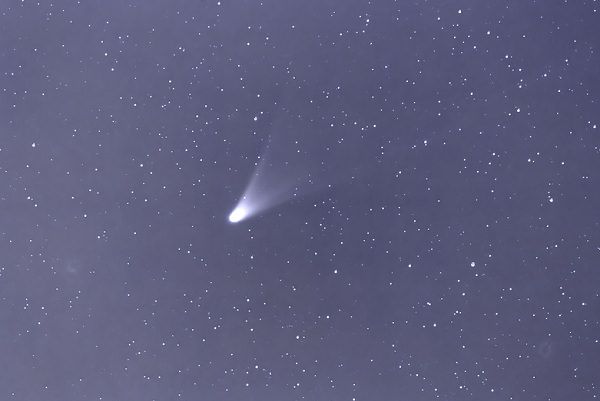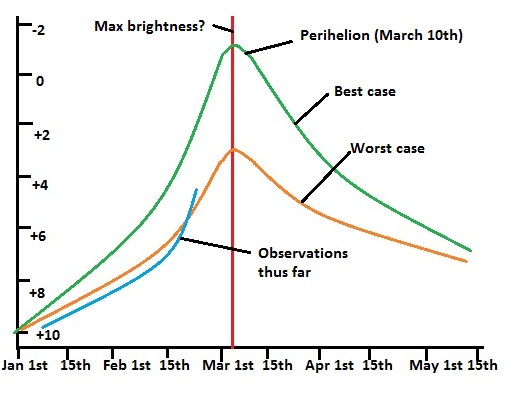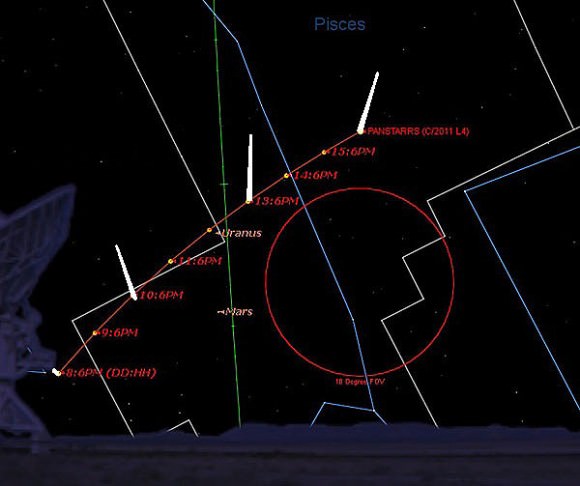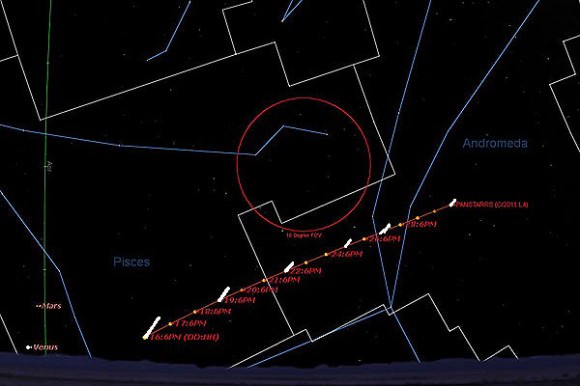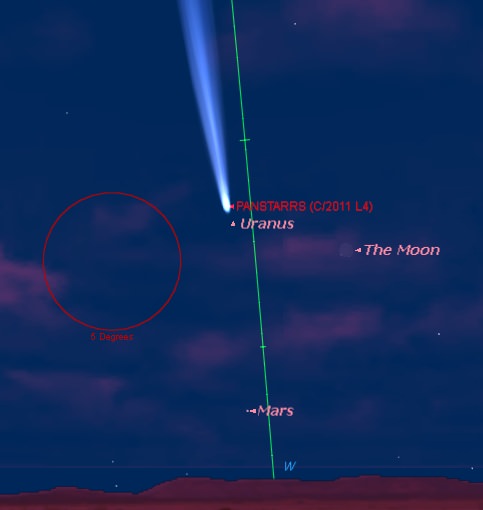Great ready. After much anticipation, we could have the
first naked eye comet
of
2013
for northern hemisphere observers in early March. As
discussed
earlier this week on Universe Today, 2013 may well be the Year of the Comet, with two bright comets currently putting on a show in the southern hemisphere and comet
C/2012 S1 ISON
set to perform the closing cometary act of 2013.
But while comet
C/2012 F6 Lemmon
won't be visible for northern hemisphere residents until April, Comet C/2011 L4 PanSTARRS (which we'll refer to simply as "Comet PanSTARRS" from here on out) may well become a fine early evening object in the first two weeks of March.
That is,
if
it performs. Comets are often like cats. Though we love posting pictures of them on the Internet, they often stubbornly refuse to perform up to our expectations. Some comets have been solid performers, like Hale-Bopp in 1997. Others are often promoted to great fanfare like Comet Kohoutek in 1973-74, only to fizzle and fade into notoriety.
[caption id="attachment_100186" align="alignnone" width="514"]
The projected brightness curve of comet PanSTARRS. Created by the author and based on data from www.aerith.net, JPL/Horizons light curves, & Guy Ottewell's 2013 Almanac.[/caption]
Comet PanSTARRS
was discovered on June 6
th
, 2011 by the Panoramic Survey Telescope and Rapid Response System (PanSTARRS) based on the summit of Haleakala on the island of Maui. Astronomers knew we could have a potentially bright comet inbound due to its initial discovery distance of 7.9 astronomical units (AUs) from the Sun. The
comet brightened ahead of expectations
and was first picked up by an amateur astronomer on March 28
th
of last year (J.J. Gonzalez of Leon, Spain) at 14
th
magnitude.
Currently in the constellation Grus at a distance 1.18 AU from the Earth, Comet PanSTARRS is already an impressive sight for southern hemisphere observers. Astrophotographer
Luis Argerich
based out of Buenos Aires Argentina provided us with some ultimate pictures of the comet as it begins to unfurl its dust tail. Argerich estimates that Comet PanSTARRS was at about +4
th
magnitude earlier this week, slightly dimmer than the +3
rd
magnitude star Alpha Indi.
[caption id="attachment_100181" align="alignnone" width="580"]
Comet PanSTARRS caught on the morning of February 12th, 2013 along with an Iridium satellite flare. (Credit Luis Argerich - Nightscape Photography. Used with permission).[/caption]
The stated magnitudes of comets may often be deceptive. Much like the quoted magnitudes of nebulae, the actual
observed
brightness of a comet might be quite low. This is because said brightness is spread out over a large apparent surface area, in contrast to a point light source such as a star. A +2
nd
magnitude star may be observable in the dusk sky, while a comet of similar brightness can be a tough catch or invisible altogether.
Comet PanSTARRS will then begin curving northward during the
last week of February
chasing the "0 Hour" right ascension line northward. This is because the comet has a hyperbolic
orbit
inclined 84.2° degrees relative to the ecliptic. On an 110,000+ year orbit, this is more than likely Comet PanSTARRS first journey through the inner solar system.
Comet PanSTARRS will pass less than a degree from the 4
th
magnitude stars of Gamma and Delta Piscium on February 25
th
. Interestingly,
another
potential bright comet is "chasing it." Comet C/2012 F6 Lemmon is also on a high inclination orbit and will only be 25° from Comet PanSTARRS on February 27
th
in the constellation Phoenix. Both will be 22° degrees from the Sun and will make for fine wide-field targets (two comets in one photograph!) starting this weekend.
[caption id="attachment_100183" align="alignnone" width="580"]
The path of Comet PanSTARRS looking west about an hour after local sunset from 30 degrees north latitude on March 8th-16th.[/caption]
But early March is when the real action may begin. Comet PanSTARRS will reach an altitude of greater than 5° at dusk for northern hemisphere observers based around 30° north latitude looking low to the southwest starting on March 5
th
. On the same date, the comet will make its closest approach to Earth at 1.1 AUs distant.
The comet will then begin gaining altitude, passing less than one degree from the +3.5
th
magnitude star Iota Ceti on March 8
th
. Keep in mind, Daylight Saving Time begins for a majority of U.S. residents on March 10
th
, so while we'll be looking for the comet around 7:00 pm local on the first week of March, it'll be at 8:00 pm on the second week. Comet PanSTARRS also reaches perihelion at 0.3 AUs from the Sun just outside Mercury's orbit on the same date. One wonders… could NASA's Messenger spacecraft spy it from its vantage point in orbit about Mercury 0.6 AUs distant?
[caption id="attachment_100184" align="alignnone" width="580"]
The path of Comet PanSTARRS from 30 degrees north latitude an hour after local sunset from March 17th to April 1st.[/caption]
But back down to Earth. After gaining 15-20° degrees of elevation from our northern hemisphere vantage point, Comet PanSTARRS will then begin running roughly parallel to the western horizon on each successive evening for mid-northern latitude observers. This first half of March is also when Comet PanSTARRS will have the potential to appear at its brightest. In the
best
case scenario, we'll have a comet with a -1
st
magnitude coma and a tail pointing straight up from the horizon like an exclamation point. In the
worst
case situation, we'll have a +3
rd
magnitude fuzzy comet only visible through binoculars.
[caption id="attachment_100185" align="alignnone" width="483"]
Looking west at dusk on the night of March 12th for North American viewers.[/caption]
But if you observe the comet on no other night, be sure to check it out on the evening of March 12-13
th
. The comet will have just crossed the ecliptic, and will be joined by a slim crescent Moon just over a day old. If you've got binoculars or a telescope, you might just be able to spy the planet Uranus at 6
th
magnitude only 24' from the head of the comet on March 12
th
.
Comet PanSTARRS will then continue its trek northward through Pisces into Andromeda for the remainder of March, passing within 3° of the Andromeda Galaxy M31 on April 3
rd
and crossing the galactic plane in Cassiopeia on April 25
th
. By May 1
st
, Comet PanSTARRS will have dipped back down below naked eye visibility, hopefully having put on a great show. It's interesting to note that this may be the first
really bright
northern hemisphere comet we've had since the advent of DSLR astrophotography. Back in the 1990's most of us were shooting comets Hale-Bopp and Hyakutake with ye 'ole film cameras, and
Comet C/2006 P1 McNaught
put on its best 2007 showing for the southern hemisphere. We fully expect some stunning pictures if this comet performs up to expectations!
Graphics where created by the author using Starry Night software.
See more of Luis Argerich's outstanding southern sky astro-images and much more at
Nightscape Photography
.
 Universe Today
Universe Today
